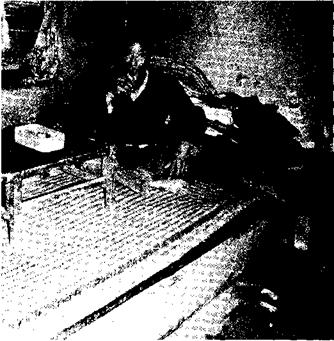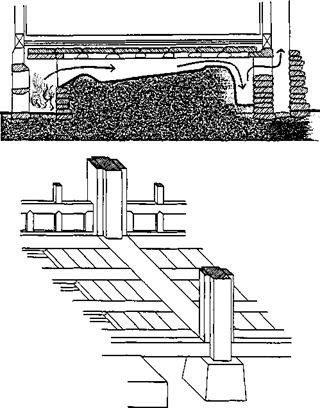The constraints imposed by the ondol system of floor heating were a major factor in the interior layout of traditional Korean homes.
Confucian philosophy was central to the division of the
|
93 Section and perspective views of the о ndol heating system and wooden floor structures. |

dwelling into the anch’ae, sarangch’ae, and haengnagch’ae, but the composition of rooms within each of those buildings was based on a distinction between rooms with floor heating (pang) and those without (таги). Furthermore, the size of each pang and the number of pang connected to the same heating system were determined by the physical limitations of the ondoTs effectiveness.
Thus, each of the three areas of a yangban’s estate was made up of rooms small enough to be heated effectively by the ondol (the number of pang dependent on a single furnace was similarly limited), as well as a number of rooms without any heating devices that had no such size limitations (Figure 92). The former were traditionally used as private apartments, and the latter as ceremonial spaces.
The Structure of the Ondol
The ondol system ut ilizes the heat of smoke from an enclosed furnace. Excess heat from the furnace passes through flues located beneath the floor to a chimney at the other end of the room or rooms. The furnace is most commonly located in the pudk (kitchen), and the rooms it heats are called pang. Once smoke has passed through the flues to heat the pang, it is ventilated through an external chimney.
The floors of the heated rooms, or pang, were traditionally constructed of a layer of thin ondol stone slabs laid upon kudul stone risers, covered with a thick layer of clay and a top layer of varnished ondol paper.
The ondol was designed in such a way that flues distributed heat evenly throughout the room. It was traditionally fueled by wood, but anthracite coal and even porous briquettes may have been used on occasion, when forestry management considerations required alternative fuels (Figure 93).
Ondol, Kang, and Pao
The ondol of Korea is similar to the heating system known as kang which is used widely in homes across northern China and Manchuria, but there are essential differences. The kang heating system in China is designed for use in homes in which people sit on chairs, so it is installed only in the bed platforms of the sleeping quarters (Figure 94). The Mongolians also use floor heating in their pao (semipermanent dwellings); this shares features in common with both the kang of China and the ondol of Korea and can therefore be assumed to have some connection with both.
While the Chinese custom of sitting on chairs inside the home meant that floor heating was used only in sleeping areas and its potential benefits were never fully utilized, the use of the ondol heating system was so well matched to the Korean people’s custom of sitting on the floor that it has become a basic identifying feature of the Korean way of life.
![]()
 The Combination of Ondol and Taech’ong
The Combination of Ondol and Taech’ong
Stone wares are habitually used even today among the common people of Korea for cooking, keeping foods warm, and serving food at mealtimes. Similarly, the ondol heating system is still found throughout the peninsula. Among the reasons that it became so ubiquitous are that it is simply constructed from granite and high-quality clay readily available throughout the country, it is fueled by wood, which is a plentiful resource in heavily forested Korea, and it is best suited to prevailing climatic conditions.
Nomura Takafumi explains in Chosen no minka (Traditional Korean dwellings) that the ondol heating system was probably introduced to the ruling classes by provincial officials who traveled to the capital under the highly-centralized bureaucracy of the Choson-dynasty government:
There are many differing theories as to the origin of ondol. The most plausible of these, given the evidence we have to date, appears to be that it was first developed in Koguryo, which was the northern part of Korea during the Three Kingdoms period [37 B. C.-A. D. 668] … It does seem safe to say that floor heating was used in Koguryo long before it was known in China… Even when the ondol system came into widespread use during the Koryo period, it seems to have been popular only in rural areas among the common people, and not among the
upper classes or in the major cities, where people generally slept on raised beds instead of on quilted mats on the floor. The first appearance of ondol in the homes of the upper classes was during the Choson dynasty, when the floors of ondoi-heated rooms [pang] were covered with oiled paper … It is likely that this custom was introduced to the capital and other cities by government officials and warriors based in the provinces… It is common for customs and habits of the upper classes to filter down to the middle and lower classes, but the ondol heating system appears to have been a rare example of the opposite: a lower-class custom filtering up to the elite.7
By contrast, the wooden-floored taech’ong, which was essentially a ceremonial space, was an architectural element that spread from the central aristocracy to the residences of the yanghan in the provinces, and from there to residences of the common people, as the principles of Confucianism gained wider acceptance in Korean society. As a result, if we now compare the traditional homes extant in Seoul to those in the provinces, we can observe two different modes of development: one centered on the taech’dng, and the other centered on pudk and pang. Therefore, from this point, these two patterns will be referred to as urban and rural residential forms of composition. In both cases, however, ondoZ-heated rooms are seen side-by-side with unheated wooden-floored rooms, and it is this combination which is the single most remarkable characteristic of traditional Korean residences in general.




